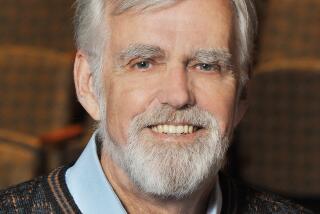Bard Boom on the Boards : Theater Season Will Be Weighted by Productions Honoring Shakespeare Anniversary
Four hundred years ago, William Shakespeare made his debut as a playwright with “The First Part of King Henry the Sixth.” To be precise, the play was performed for the first time in London on March 3, 1592--though just how much of it he wrote is still subject to debate.
Be that as it may, 1992 will bring a Shakespearean groundswell in English-speaking theaters the world over to celebrate the 400th anniversary of the Bard’s debut--perhaps not on the order of the 1991 bicentennial commemorations of Mozart’s death but surely wide and deep enough to make a useful dent in our cultural consciousness.
In Orange County alone, playgoers will have the chance to see a minimum of seven Shakespeare productions mounted in all sizes and settings by at least four companies important to shaping the local theater scene.
* South Coast Repertory in Costa Mesa, the county’s largest professional troupe, will do “Twelfth Night, or, What You Will” (Jan. 10 to Feb. 16 on the Mainstage).
* Alternative Repertory Theatre in Santa Ana, the small but ambitious amateur storefront troupe, will do “The Tempest” (April 17 to June 13).
* The Grove Shakespeare Festival in Garden Grove, the county’s second-largest professional company, will do “Macbeth” (June 25 to July 25), “The Tempest” (July 30 to Aug. 29) and “The Merry Wives of Windsor” (Sept. 3 to Sept. 26).
* Shakespeare Orange County, the new professional classical troupe at Chapman University in Orange, will do “The Winter’s Tale” (opening July 10 for four weeks) and “Hamlet” (opening Aug. 7).
There are likely to be many more offerings selected from the Bard’s canon of 38 plays staged by various local groups. But so far nobody has volunteered to mount any of the three parts of “Henry VI.”
When the initial installment of that cycle first appeared, Shakespeare was not yet 28. Christopher Marlowe, two months his senior, had won fame several years earlier for the two parts of his first play, “Tamburlaine.” And many literary sleuths bent on ferreting out the arcane truth of authorship see the influence of Marlowe’s style, particularly in Shakespeare’s powerful opening lines about the death of King Henry V:
Hung be the heavens with black, yield day to night!
Comets, importing change of times and states,
Brandish your crystal tresses in the sky
And with them scourge the bad revolting stars,
That have consented unto Henry’s death!
If those were in fact the first of the Bard’s lines to be heard in the theater, Charles Vere and the Oxford Shakespeare Society would argue they were actually written by Edward de Veer, the 15th Earl of Oxford.
Vere (a descendant of De Veer), who is going on a national tour sponsored by the society, will try to make that case at Chapman University in April, following lectures at Yale and Brown universities, among other stops. His appearance at Chapman will be co-sponsored by Shakespeare Orange County, headed by Thomas F. Bradac.
Bradac, who teaches at Chapman and also is the former artistic director of the Grove, said he doesn’t subscribe to Vere’s theory.
“I’m always being asked who really wrote the plays,” he noted. “I think Shakespeare did. But the question of authorship has gained renewed currency since the mid-’80s.”
Come the first preview of SCR’s “Twelfth Night” on Jan. 3, the Bard himself might ask the same question. Director David Chambers and his associates are about to stage a Caribbean version of the play, filled with the masks and images of Carnival, themes taken from the Afro-Cuban religion Santeria and the sound of conga drums.
“As someone who teaches Shakespeare in a contemporary world, I have to wrestle with the Shakespeare problem ,” said Chambers, who doubles as a professor at the Yale School of Drama. “The poetry is majestic, one of the strongest legacies of the Eurocentric tradition, but it can also be an oppressive instrument.
“It can denature other people’s cultures when we tell people that Shakespeare is the high standard they should strive for. It’s a very 19th-Century imperialistic vision. I’ve become increasingly interested in the elasticity of Shakespeare. I want to see how I can elasticize it in other cultural directions without ripping apart the text.”
Of the county’s three largest theater companies, only the Laguna Playhouse will not be taking part in the Bard boom. But it intends to do some serious theatrical stretching of its own when it revives Henrik Ibsen’s “An Enemy of the People” (Jan. 16 to Feb. 9).
Playhouse executive director Richard A. Stein said that Ibsen’s 1882 attack on social complacency and vested interests in a small resort community has a certain timeliness in view of Laguna Beach’s environmental battle over construction of the San Joaquin Hills tollway.
“We’re not taking sides,” Stein contended, adding that the Playhouse is simply hoping the production will help “stir intellectual debate.”
Meanwhile, SCR artistic director Martin Benson said the first of two world premieres he is directing this season--Jon Bastian’s “Noah Johnson Had a Whore” (Jan. 21 to Feb. 23 on the Second Stage)--is bound to stir dark laughter.
The play, which won second prize in the theater’s 1991 California contest for unproduced scripts, takes place in 1864 near a Civil War battlefield where a stage magician-turned-undertaker deals with bodies to be buried or shipped home.
“It is a wickedly funny comedy in the spirit of Joe Orton,” Benson said. “What could be macabre turns out to be comic. I think Bastian is a tremendous writing talent.”
The other Benson-directed world premiere will be Barbara Field’s “Boundary Waters” (April 3 to May 10 on the Mainstage), about a handful of university physicists who go “birding” in the northern reaches of upper Minnesota near the Canadian border in hopes of spotting the snowy owl.
Thrust into a world totally different from the one they’re used to, each of the scientists “experiences the emotion of ecstasy,” Benson said.
One play he will not direct is John Gray’s “Billy Bishop Goes to War,” a virtual one-man show about a real-life World War I ace who became a combat pilot as a lark and ended up with 72 “kills” to his credit. Benson said he has been trying to get the play for SCR ever since he saw it a decade ago in Vancouver.
Combining music, comedy and drama, “Billy Bishop” will star Ben Halley in the title role (March 10 to April 12 on the Second Stage). Halley, who will direct himself, has done the show in other venues for years.
“We’ve always wanted him to do it here,” said Benson, noting both the artistry and the incongruity of a large black man playing wispy little Billy Bishop. “He’s one of those actors with whom we’d like to establish a long relationship.”
(Halley appeared in “Haut Gout” during the mid-’80s and also is appearing in “Twelfth Night.”)
Finally, the 1992 theater season may well set a record for SCR, though not within the confines of the county. Two of its commissioned plays are about to open in New York--one on Broadway and one off Broadway--with a third possibly opening later in the season if producer interest pans out.
David Margulies’ “Sight Unseen,” mounted on the SCR Second Stage last fall, currently is in rehearsal at off Broadway’s Manhattan Theatre Club. The opening is scheduled for the second week of January, SCR literary manager Jerry Patch said.
Howard Korder’s “Search and Destroy,” which was seen on the SCR Mainstage in January, 1990, goes into rehearsal at Broadway’s Circle-in-the-Square with an opening expected in February.
“I hear (Richard Greenberg’s) ‘The Extra Man’ is also going to get a production, though we don’t know how firm that is,” Patch said. “So it’s possible three of our commissioned plays will be on in New York. That has never happened before.”
The importance of getting New York productions for SCR plays, he noted, has everything to do with fund raising and little to do with potential royalties. It means that SCR will gain a higher profile as the creator of new work and greater prestige among the national philanthropic foundations, many of which are located in New York.
“That’s what’s in it for us,” Patch said.
Not surprisingly, in tough economic times, greater access to large non-corporate donors is more welcome than ever.
More to Read
The biggest entertainment stories
Get our big stories about Hollywood, film, television, music, arts, culture and more right in your inbox as soon as they publish.
You may occasionally receive promotional content from the Los Angeles Times.










